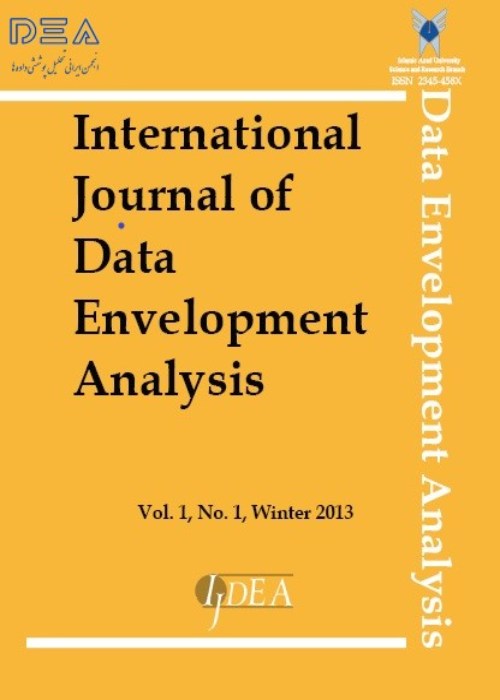فهرست مطالب
International Journal of Data Envelopment Analysis
Volume:5 Issue: 4, Oct 2017
- تاریخ انتشار: 1396/08/03
- تعداد عناوین: 6
-
Pages 1361-1385
One of the problems of the data envelopment analysis traditional models in the multiple form that is the weights corresponding to certain inputs and outputs are considered zero in the calculation of efficiency and this means that not all input and output components are utilized for the evaluation of efficiency, as some are ignored. The above issue causes the efficiency score of the under evaluation unit not to be calculated correctly. One of the ways to deal with the pseudo-inefficiency is to use data envelopment analysis models with multi-criteria structure. In this regard, we first investigate the models of data envelopment analysis with multi-criteria structure and further, with regard to the ability of the ratio-based data envelopment analysis models, we develop data envelopment analysis models with a multi-criteria structure for ratio data and the feasibility and the bounded condition of the above models and their efficiency intervals are described. By presenting a numerical example, we compare the efficiency scores obtained from the models presented with the previous models and we show that the proposed models can be used to deal with the pseudo-inefficiency and efficiency underestimation. Finally, we present the results.
Keywords: Multi-criteria data envelopment analysis, Discrimination power, Weight dispersion, DEA-R, Pseudo-inefficiency -
Pages 1387-1397
In this paper, the financial efficiency of football clubs in English Premier League during 2016-17 season is determined. From a methodological perspective, we use Data Envelopment Analysis (DEA), a deterministic nonparametric frontier method. In particular, variable returns to scale and slack based measure are employed to assess whether teams are spending more resources than they need to achieve efficiency. DEA allows for inclusion of multiple inputs and outputs in assessing the efficiency and provides benchmarks for inefficient clubs. The input parameters selected are total expenses which include the salaries of players, coaches, managers and supporting staff. The output variables being revenue generated, profit gained and points scored at the end of the season.
Keywords: Data Envelopment Analysis, Slack Based Measure, Football, Efficiency -
Pages 1399-1410Unemployment is one of the most important economic problems in Iran, so that many of its managers plan to increase employment rates. Increasing the employment rate needs to increase economic productivity which DEA is one of the most appropriate evaluation methods for estimating the productivity of similar organizations. Employment in the amount of data input and output can be just interval. In this study by solving two models, using one of which the upper bound for efficiency and using the other, the lower bound for decision making units efficiency is acquired, we provide a new model for Most productive scale size with interval data. The main purpose of this study is to determine the productivity of Iran and sensitive indicators to provide a fundamental solution to exit from unemployment. The economic sector managers can do more exact planning for economic growth.Keywords: : Employment, Data Envelopment Analysis, Efficiency, Interval data, Most productive scale size (MPSS)
-
Pages 1411-1424Anchor DMUs are a new class in the general classification of Decision Making Units (DMUs) in Data Envelopment Analysis (DEA). An anchor DMU in DEA is an extreme-efficient DMU that defines the transition from the efficient frontier to the free-disposability part of the boundary of the Production Possibility Set (PPS). In this paper, the anchor points of the PPS of the CCR model are investigated. A basic definition of anchor point based on the supporting hyperplanes of the PPS of CCR model is provided. Then, by using a variant of super-efficiency models, the necessary and sufficient conditions for a DMU to be an anchor DMU are provided via some theorems. To illustrate the applicability of the proposed model, some numerical examples are finally given.Keywords: Data envelopment analysis (DEA), Production Possibility Set (PPS), Efficient, inefficient frontier
-
Pages 1425-1433
Malmquist Productivity Index (MPI) is one of the most famous indices, which is used for estimating the productivity change of a Decision Making Unit (DMU) during the time. Virtually any empirical study that uses MPI, reports average of the productivity indices they estimate to represent the overall tendency in productivity changes. In such a case, productivity indices of a DMU are considered with equal value. In this paper, we propose using the entropy of productivity indices of all DMUs at a specific part of time as the weight of indices of that in aggregating the indices during the under study time section. Then, we use the proposed method for an empirical study of 18 Iranian companies manufacturing automobiles and automobile parts, which have been accepted in Tehran Stock Exchange.
Keywords: Data Envelopment Analysis, Entropy, Malmquist Productivity Index -
Pages 1435-1450
In data envelopment analysis (DEA), mul-tiplier and envelopment CCR models eval-uate the decision-making units (DMUs) under optimal conditions. Therefore, the best prices are allocated to the inputs and outputs. Thus, if a given DMU was not efficient under optimal conditions, it would not be considered efficient by any other models. In the current study, using common weights in DEA, a number of de-cision-making units are evaluated under the same conditions, and a number of two-stage network DEA models are proposed within the framework of multi-objective linear programming (MOLP) for finding common weights. Furthermore, using the infinity norm, common weight sets are de-termined in two-stage network models with MOLP structures.
Keywords: Data Envelopment Analysis, Common weights, Ranking, Two-stage Network, Decision-making unit


